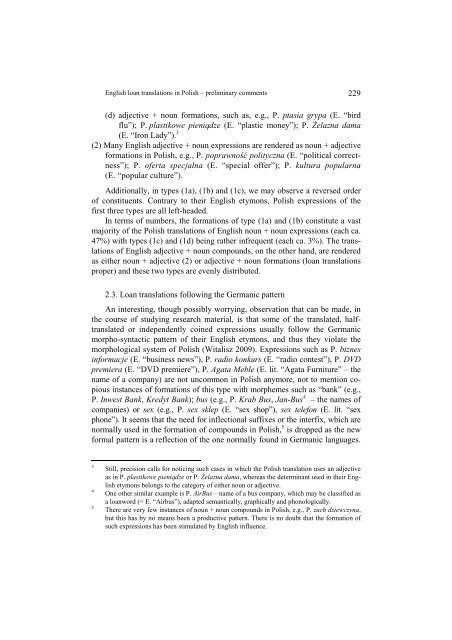s - Wyższa SzkoÅa Filologiczna we WrocÅawiu
s - Wyższa SzkoÅa Filologiczna we WrocÅawiu
s - Wyższa SzkoÅa Filologiczna we WrocÅawiu
You also want an ePaper? Increase the reach of your titles
YUMPU automatically turns print PDFs into web optimized ePapers that Google loves.
English loan translations in Polish – preliminary comments 229<br />
(d) adjective + noun formations, such as, e.g., P. ptasia grypa (E. “bird<br />
flu”); P. plastiko<strong>we</strong> pieniądze (E. “plastic money”); P. Żelazna dama<br />
(E. “Iron Lady”). 3<br />
(2) Many English adjective + noun expressions are rendered as noun + adjective<br />
formations in Polish, e.g., P. poprawność polityczna (E. “political correctness”);<br />
P. oferta specjalna (E. “special offer”); P. kultura popularna<br />
(E. “popular culture”).<br />
Additionally, in types (1a), (1b) and (1c), <strong>we</strong> may observe a reversed order<br />
of constituents. Contrary to their English etymons, Polish expressions of the<br />
first three types are all left-headed.<br />
In terms of numbers, the formations of type (1a) and (1b) constitute a vast<br />
majority of the Polish translations of English noun + noun expressions (each ca.<br />
47%) with types (1c) and (1d) being rather infrequent (each ca. 3%). The translations<br />
of English adjective + noun compounds, on the other hand, are rendered<br />
as either noun + adjective (2) or adjective + noun formations (loan translations<br />
proper) and these two types are evenly distributed.<br />
2.3. Loan translations following the Germanic pattern<br />
An interesting, though possibly worrying, observation that can be made, in<br />
the course of studying research material, is that some of the translated, halftranslated<br />
or independently coined expressions usually follow the Germanic<br />
morpho-syntactic pattern of their English etymons, and thus they violate the<br />
morphological system of Polish (Witalisz 2009). Expressions such as P. biznes<br />
informacje (E. “business news”), P. radio konkurs (E. “radio contest”), P. DVD<br />
premiera (E. “DVD premiere”), P. Agata Meble (E. lit. “Agata Furniture” – the<br />
name of a company) are not uncommon in Polish anymore, not to mention copious<br />
instances of formations of this type with morphemes such as “bank” (e.g.,<br />
P. In<strong>we</strong>st Bank, Kredyt Bank); bus (e.g., P. Krab Bus, Jan-Bus 4 – the names of<br />
companies) or sex (e.g., P. sex sklep (E. “sex shop”), sex telefon (E. lit. “sex<br />
phone”). It seems that the need for inflectional suffixes or the interfix, which are<br />
normally used in the formation of compounds in Polish, 5 is dropped as the new<br />
formal pattern is a reflection of the one normally found in Germanic languages.<br />
3<br />
4<br />
5<br />
Still, precision calls for noticing such cases in which the Polish translation uses an adjective<br />
as in P. plastiko<strong>we</strong> pieniądze or P. Żelazna dama, whereas the determinant used in their English<br />
etymons belongs to the category of either noun or adjective.<br />
One other similar example is P. AirBus – name of a bus company, which may be classified as<br />
a loanword (< E. “Airbus”), adapted semantically, graphically and phonologically.<br />
There are very few instances of noun + noun compounds in Polish, e.g., P. zuch dziewczyna,<br />
but this has by no means been a productive pattern. There is no doubt that the formation of<br />
such expressions has been stimulated by English influence.
















